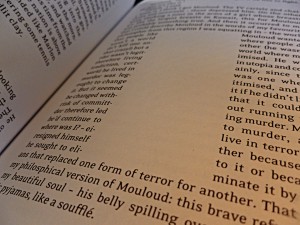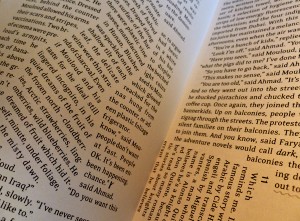The idea that revolution – real revolution – lies in an accumulation of minor changes in daily life, as opposed to violent uprisings in the streets, is finding increasing popularity, in particular among the media literate who proliferate trends with ever-increasing technical expertise. This idea is Adam Thirlwell’s point of departure in his most recent publication, Kapow!, a novel about the Arab Spring, set in Tahrir Square in 2011.
Accordingly, riots play only a minor role in the novel. For Thirlwell, the true needle bursting fundamentalist Islamic bubbles one after another, is pop culture. “Kapow!” spells out the cartoon sound for violence.
 Uprisings are both the backdrop and a metaphor for the story, which is a love triangle. Nigora, the heroine, is married to Rustam, a media-grouch, who stands for everything old, such as unfashionable gym socks, cassettes, and even burkas. Nigora finds herself increasingly attracted to Ahmad, a tech-savvy hipster in Brooklyn glasses, who makes movies on his digital camera. Ahmad believes that private life – meaning drugs and food, books and movies, fashion and sex – is “larger than the revolution.” It is. His activities have expanded his horizon beyond the borders of Egypt and they connect him in style and thinking with youth cultures around the world.
Uprisings are both the backdrop and a metaphor for the story, which is a love triangle. Nigora, the heroine, is married to Rustam, a media-grouch, who stands for everything old, such as unfashionable gym socks, cassettes, and even burkas. Nigora finds herself increasingly attracted to Ahmad, a tech-savvy hipster in Brooklyn glasses, who makes movies on his digital camera. Ahmad believes that private life – meaning drugs and food, books and movies, fashion and sex – is “larger than the revolution.” It is. His activities have expanded his horizon beyond the borders of Egypt and they connect him in style and thinking with youth cultures around the world.
They connect him, most importantly, to Thirlwell’s narrator, a stoned young Jewish man in a London taxi on his way to a hipster lesbian joint. By introducing a Jewish narrator, as the author explains in a video interview, he intended to tell the story from what at first appears to be a great distance, as measured by geography, culture and religion. But these criteria, as Thirlwell seems to suggest, are no longer pivotal. Much more important are the references in communication, entertainment, style and even food, which the figures share across borders, geographical and religious.
 Popular culture as a conciliatory force not only informs the plot of the novel, it also makes its mark in the text’s appearance. Dialogues from films and descriptions of consumer goods here come in the shape of text design. Passages – single sentences or whole paragraphs – are inserted in various formations into the text. Kapow! develops an aesthetics of digression, both literary and visual. In the words of the inebriated narrator: “I was imagining a story that was made up of so many digressions and evasions that in order to make it readable it would need to be divided into every direction.” The digressions provide the novel an undeniably stylish look (though they also make for a somewhat bumpy read in what is already a demanding literary experiment). The point is: style – lifestyle – is crucial. It might, according to Kapow!, play a role in international, interreligious and intercultural understanding.
Popular culture as a conciliatory force not only informs the plot of the novel, it also makes its mark in the text’s appearance. Dialogues from films and descriptions of consumer goods here come in the shape of text design. Passages – single sentences or whole paragraphs – are inserted in various formations into the text. Kapow! develops an aesthetics of digression, both literary and visual. In the words of the inebriated narrator: “I was imagining a story that was made up of so many digressions and evasions that in order to make it readable it would need to be divided into every direction.” The digressions provide the novel an undeniably stylish look (though they also make for a somewhat bumpy read in what is already a demanding literary experiment). The point is: style – lifestyle – is crucial. It might, according to Kapow!, play a role in international, interreligious and intercultural understanding.
Naomi Lubrich, Media